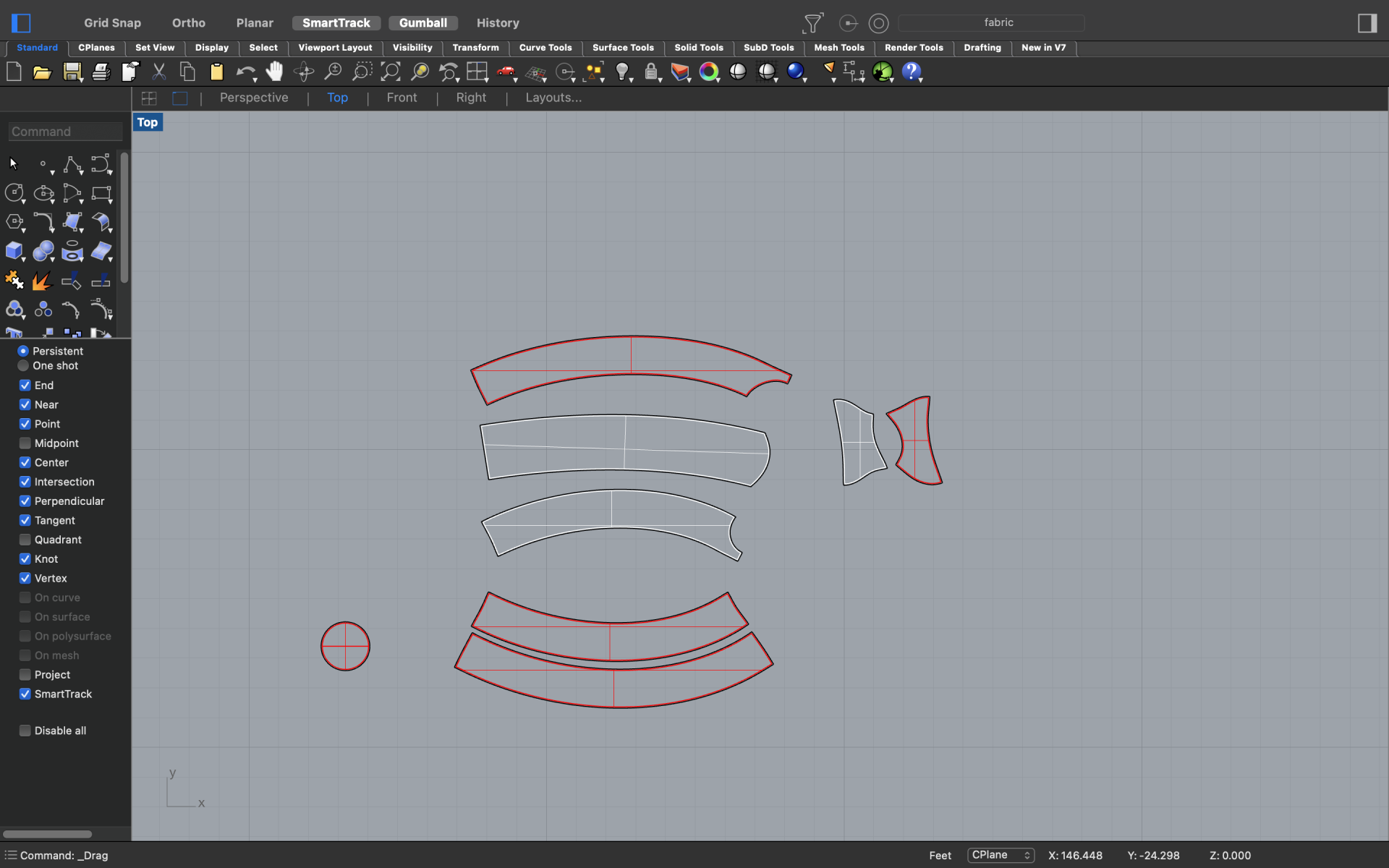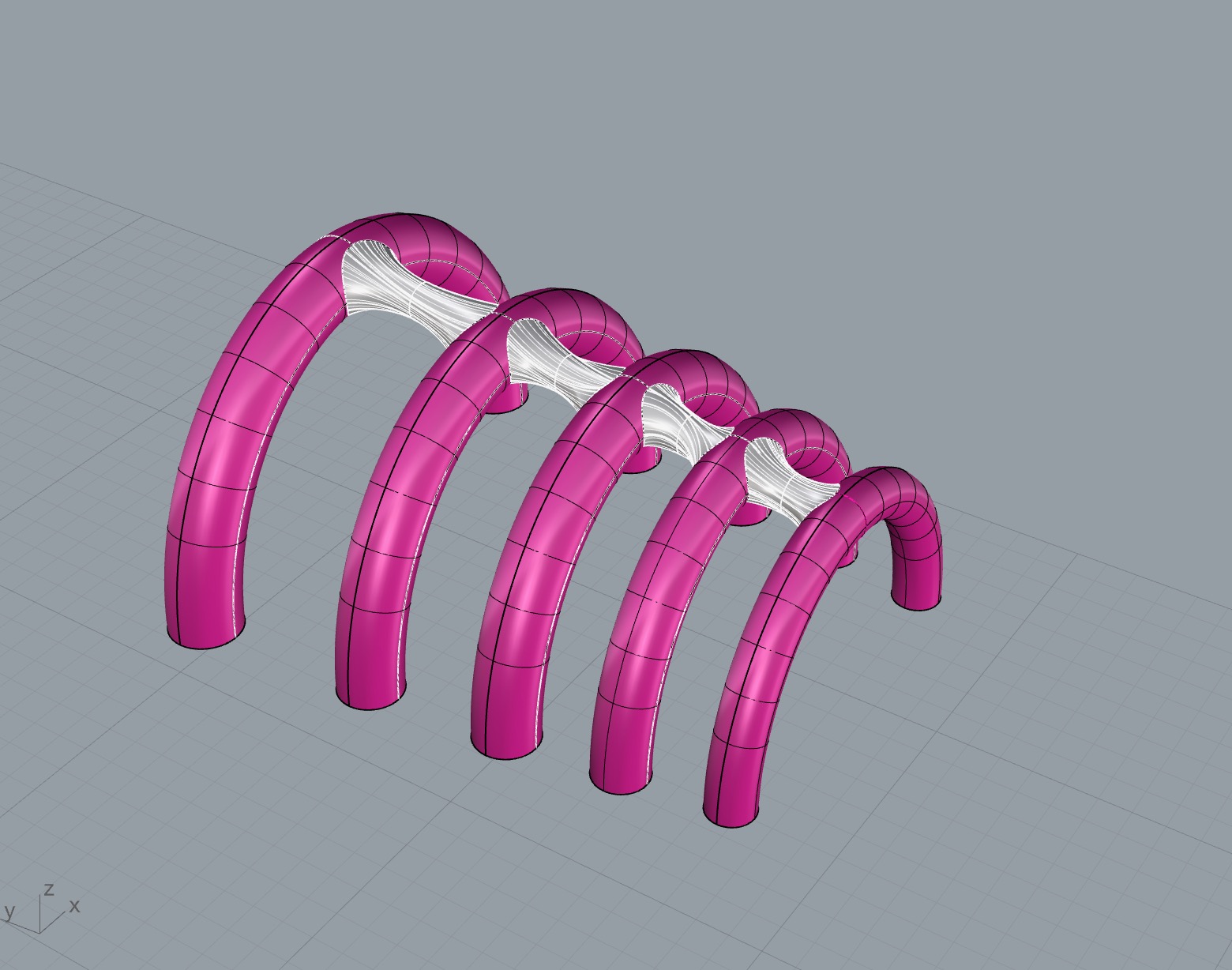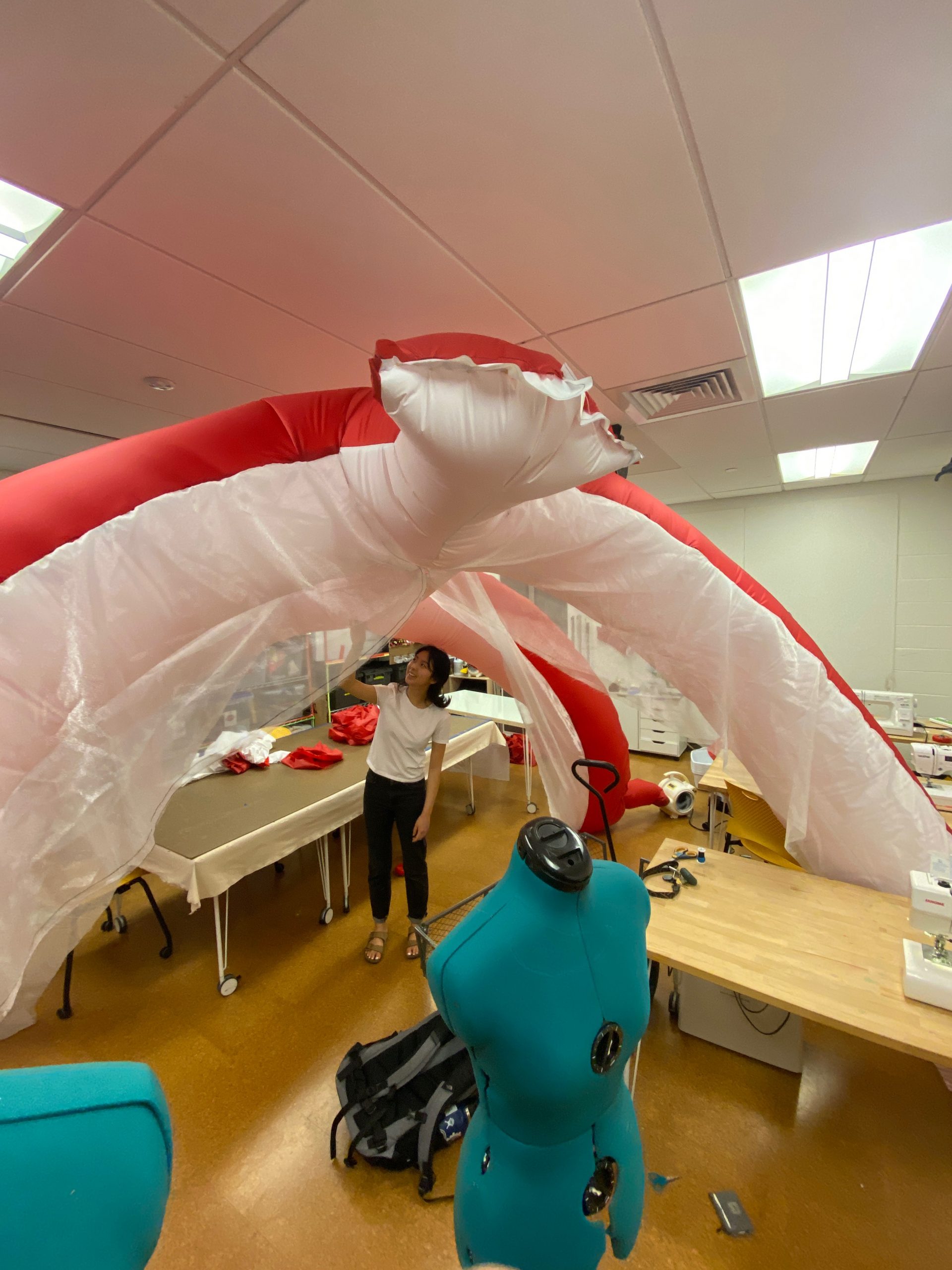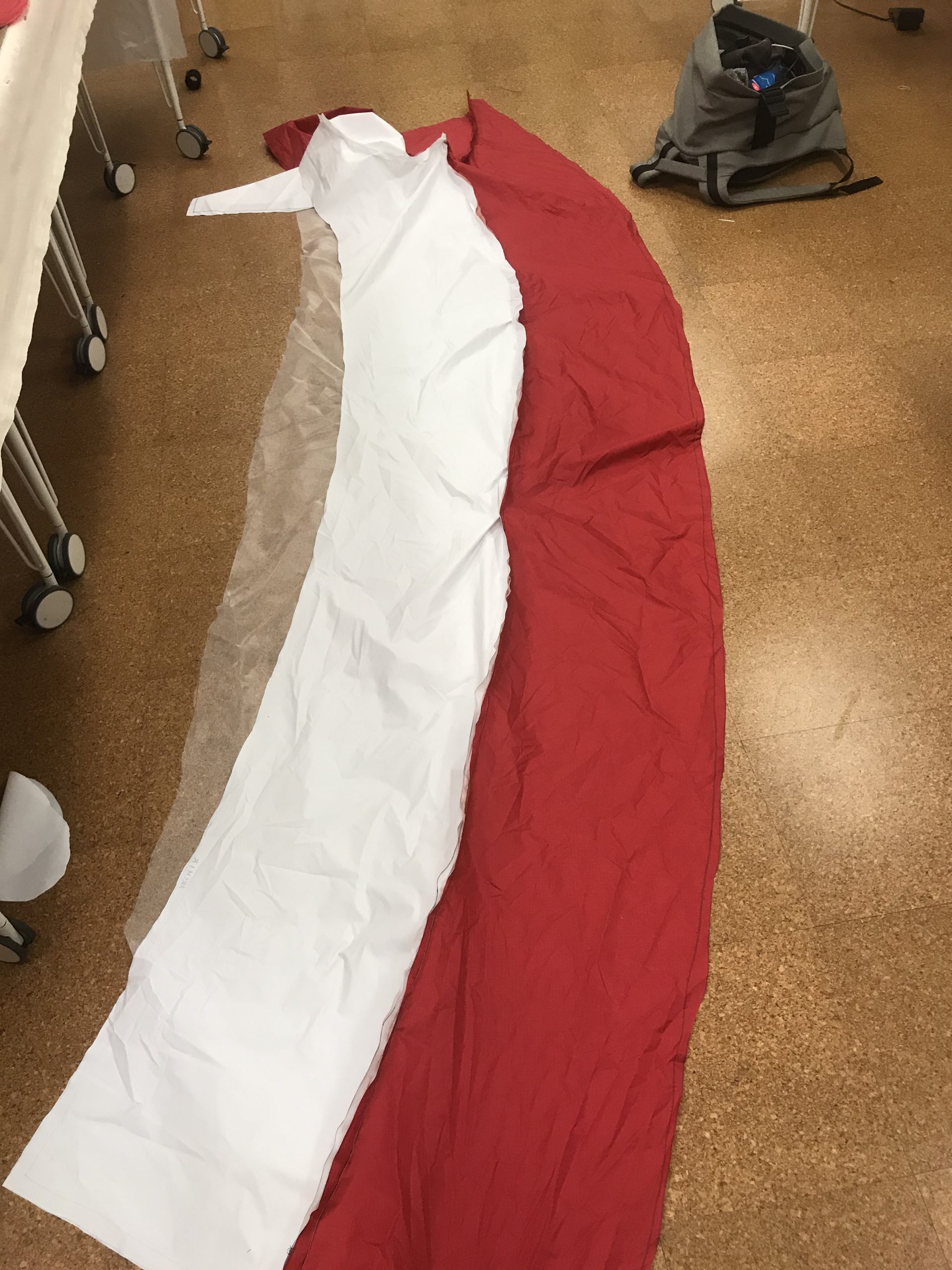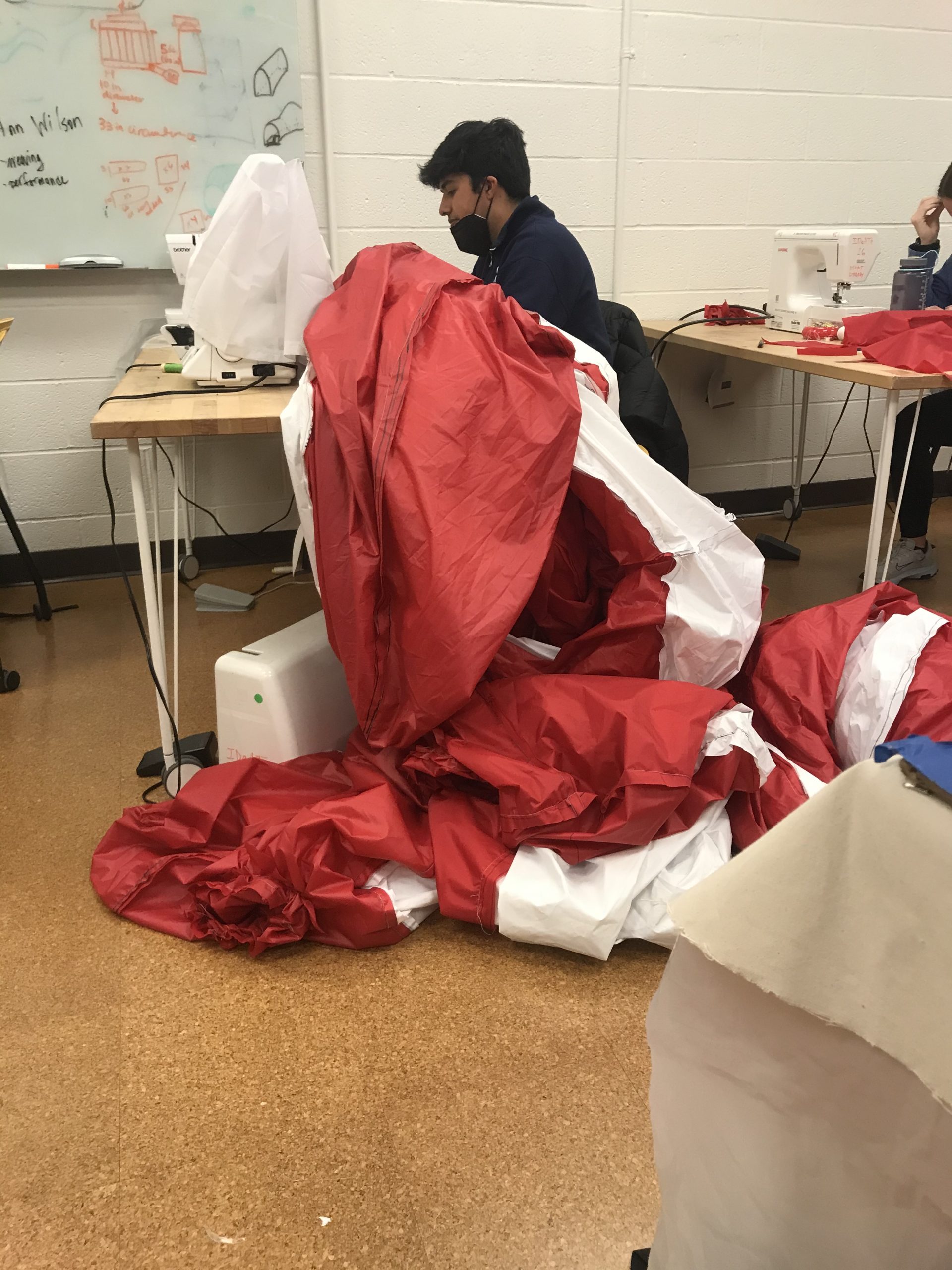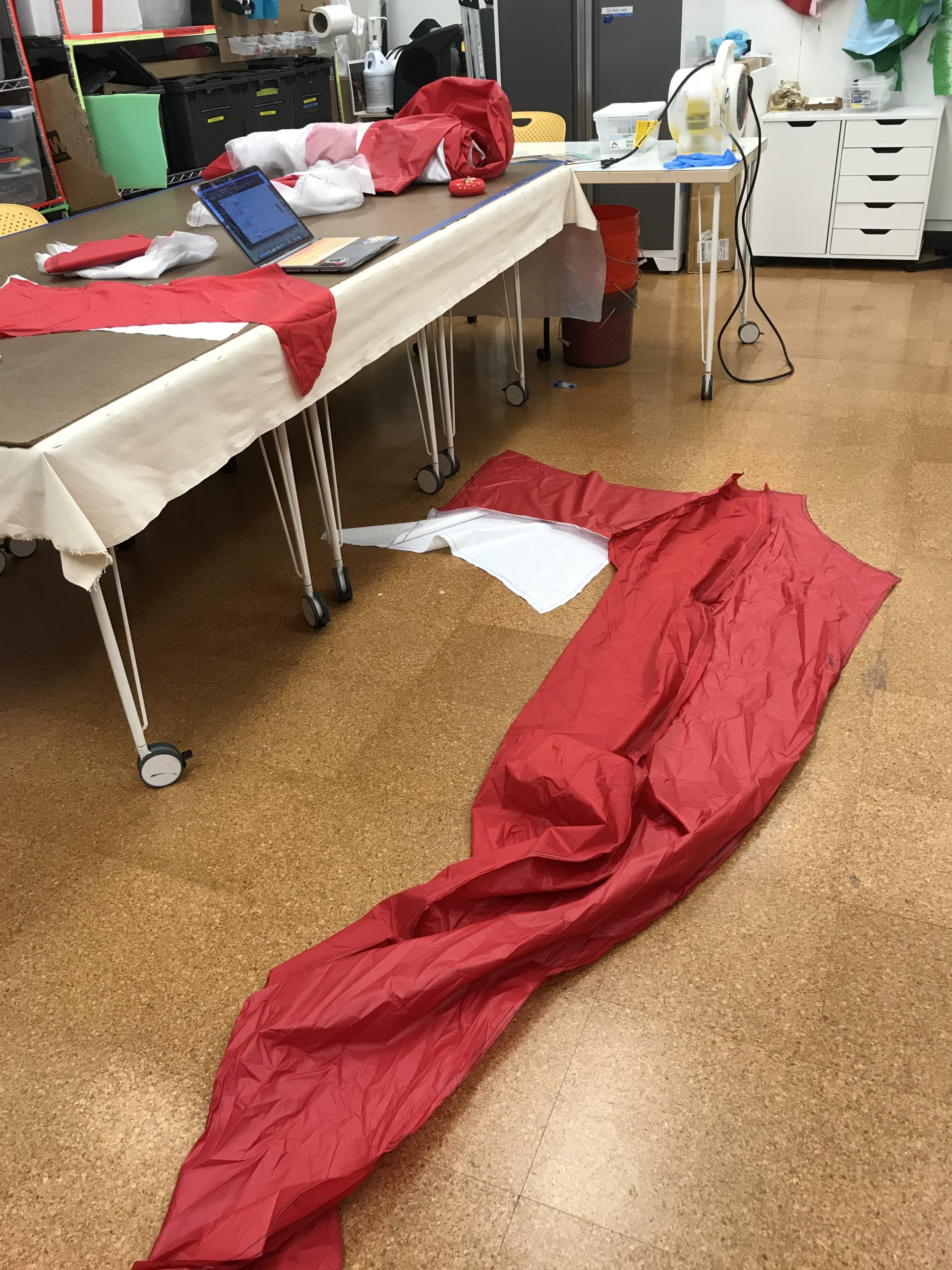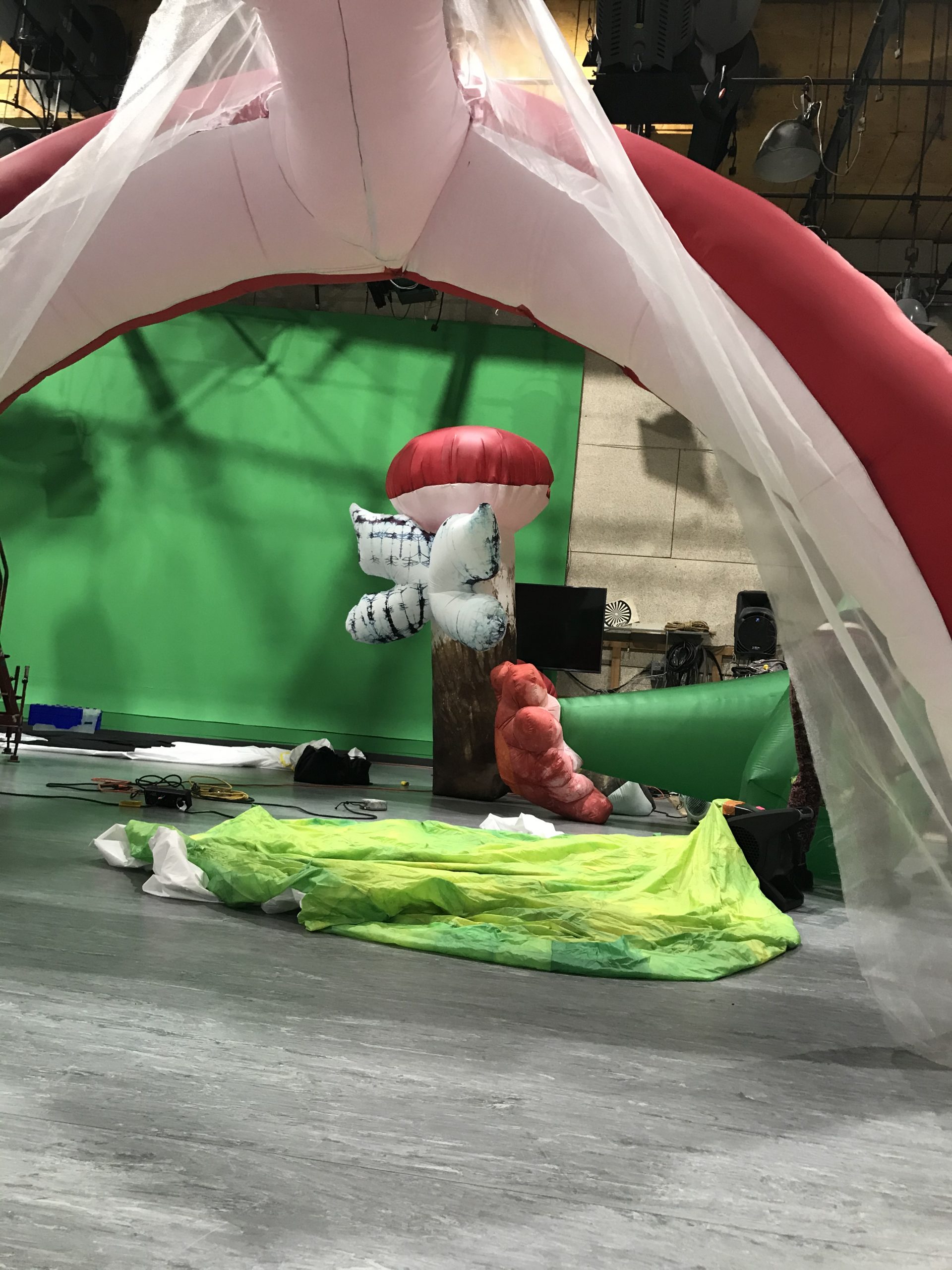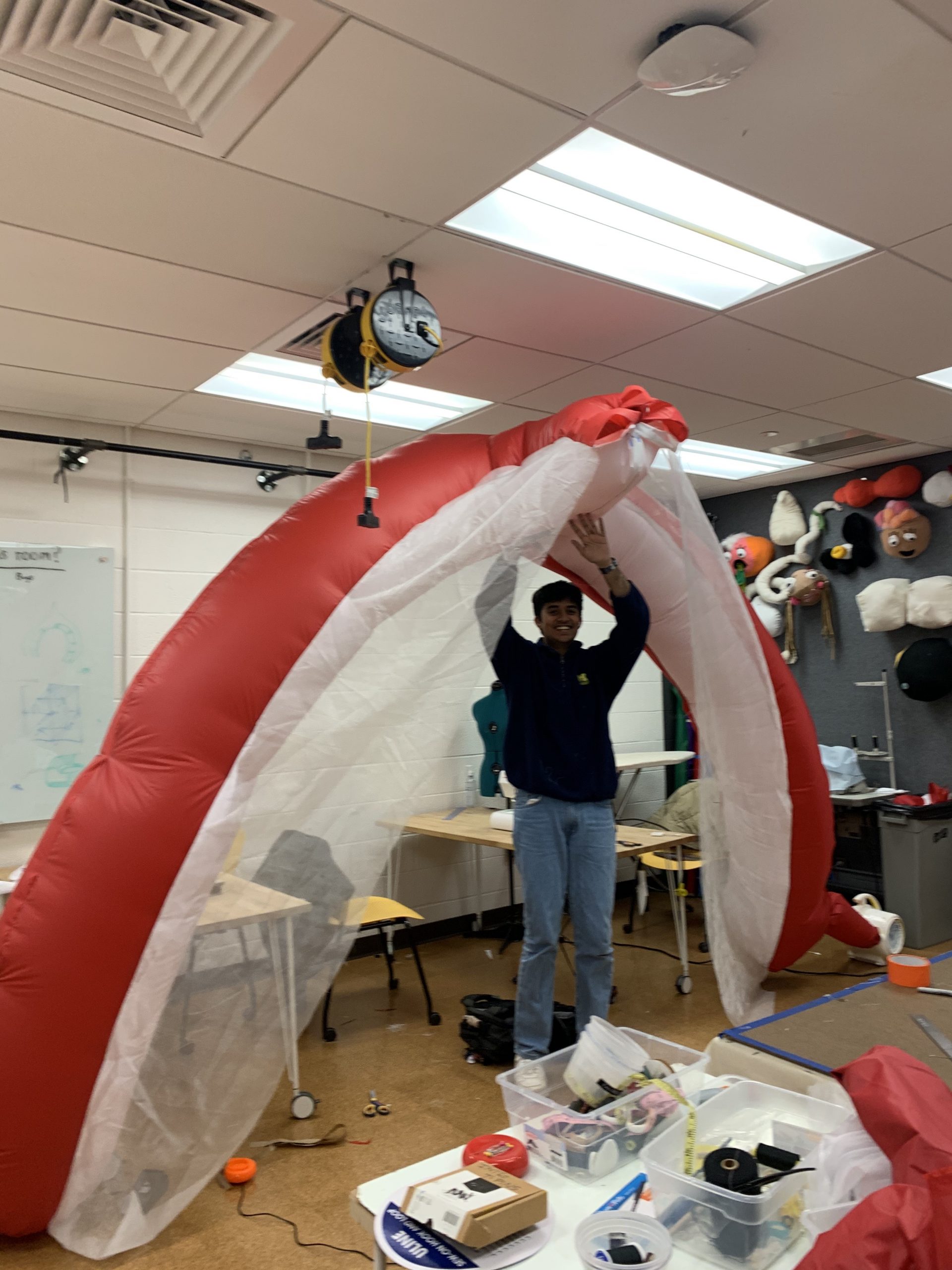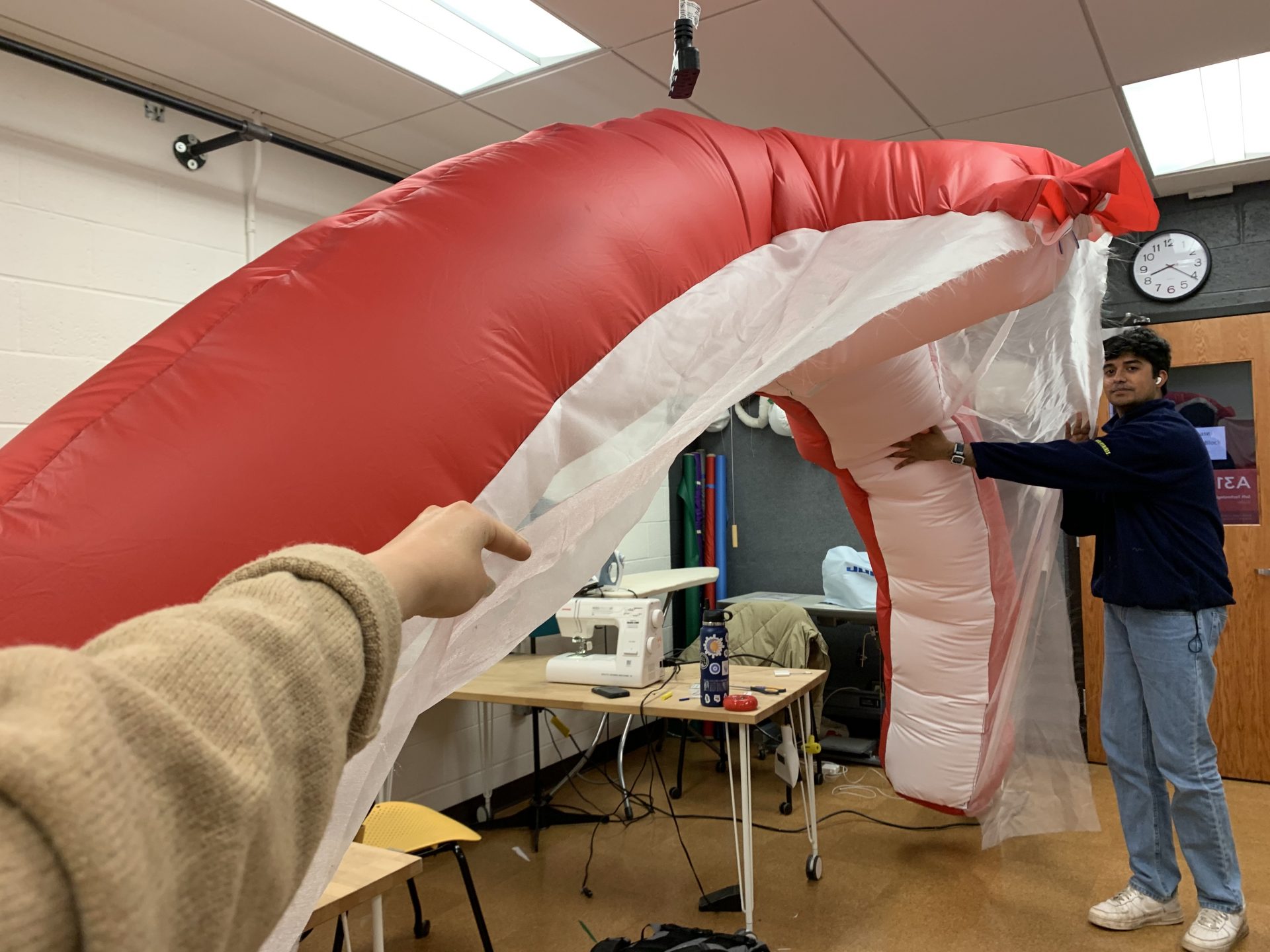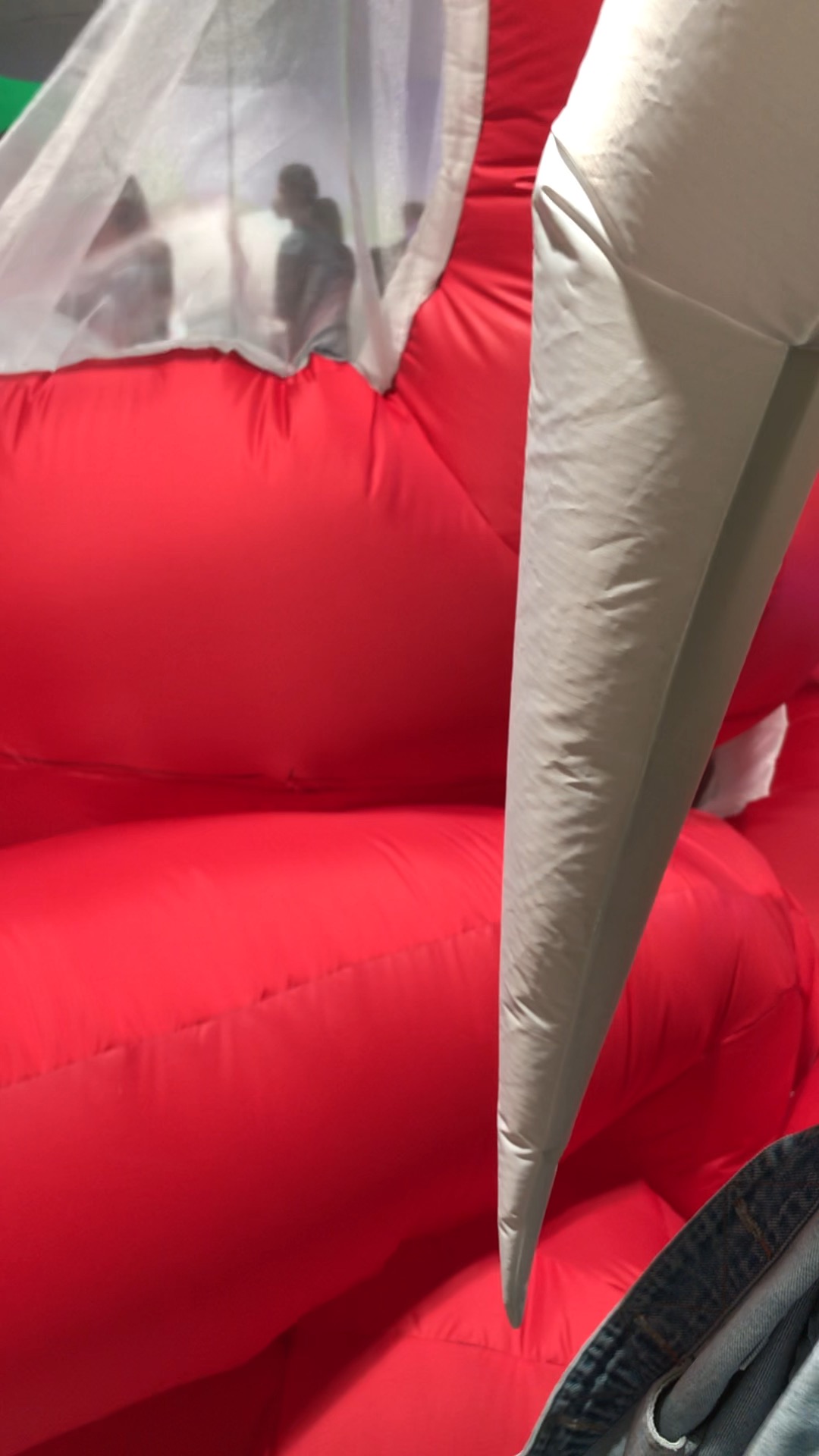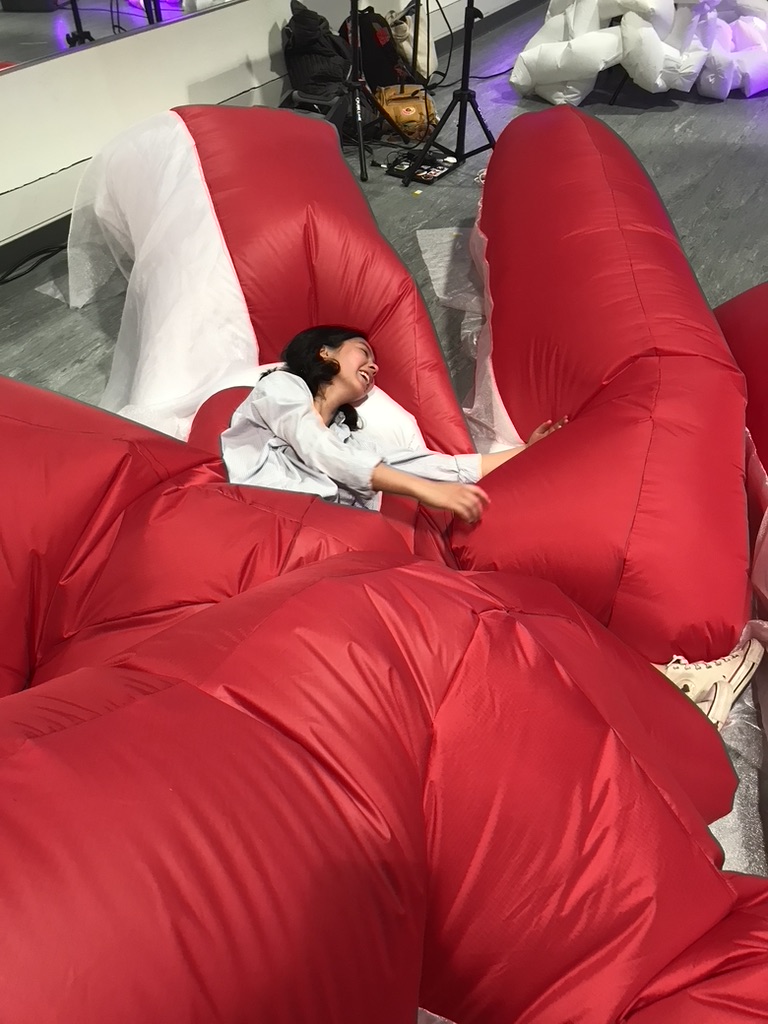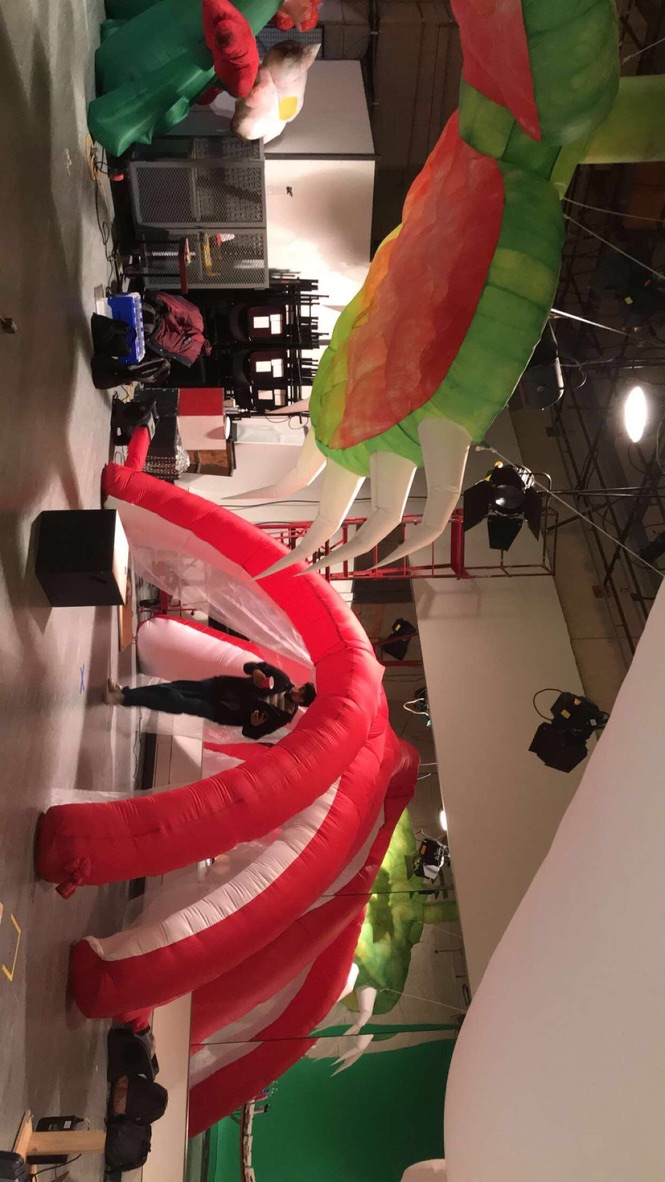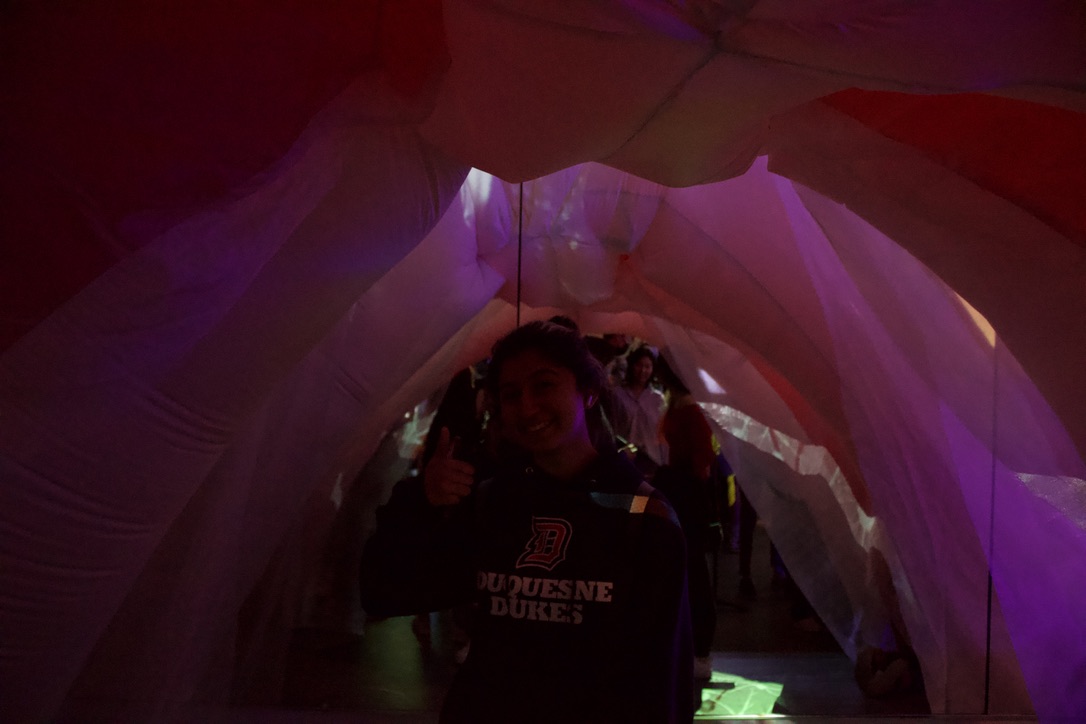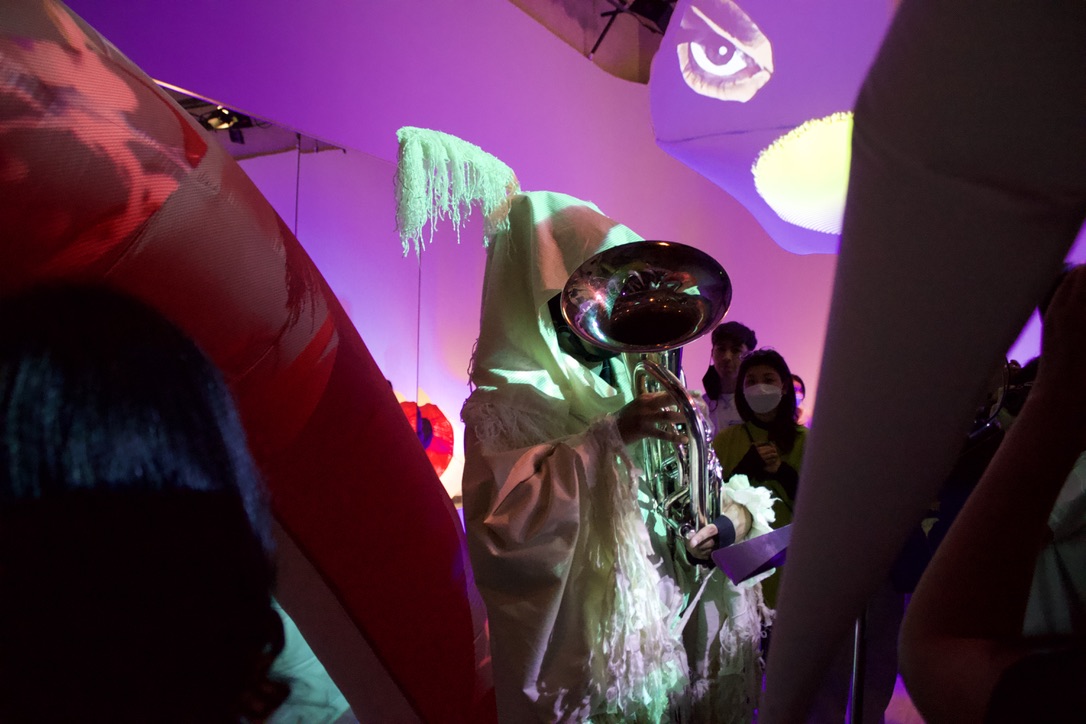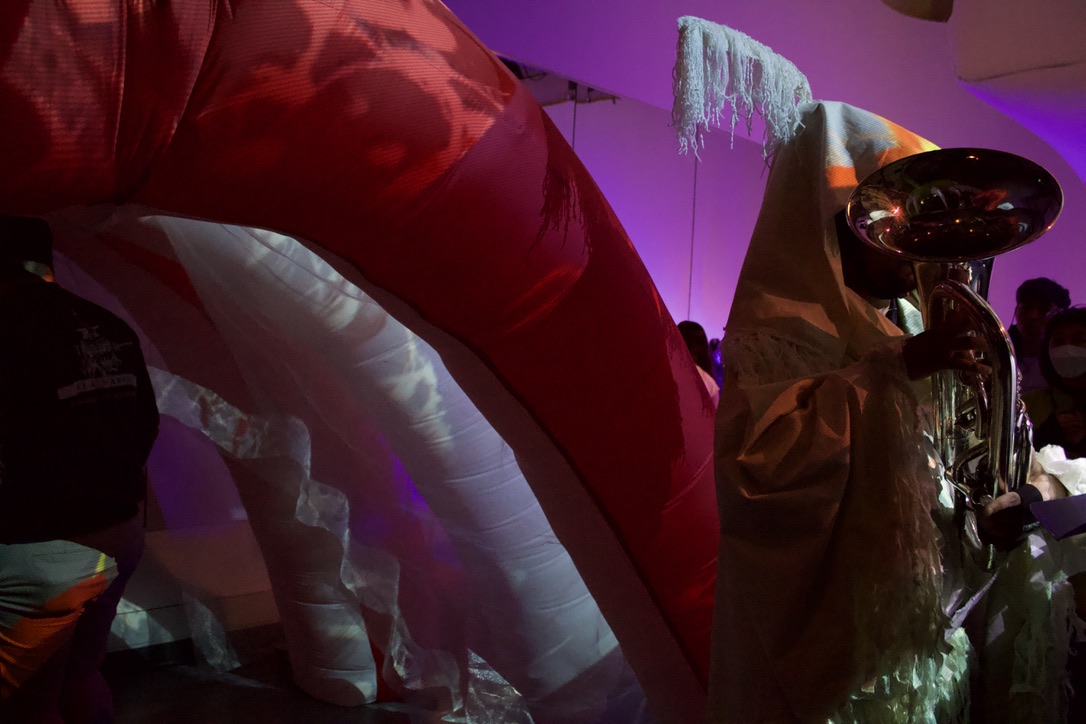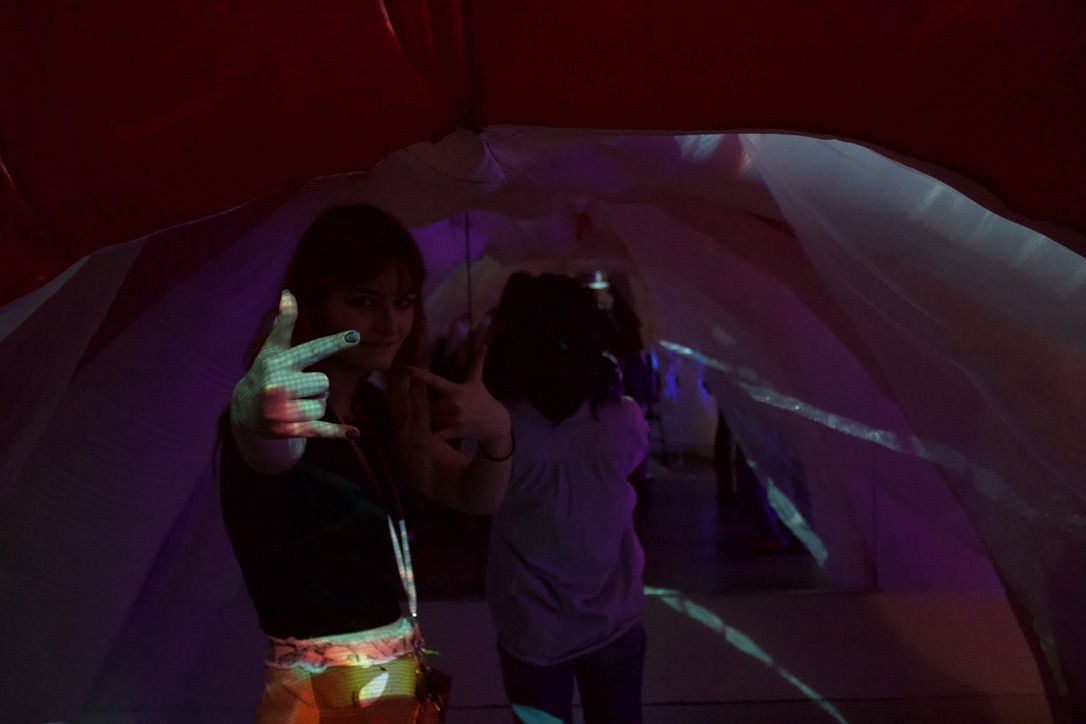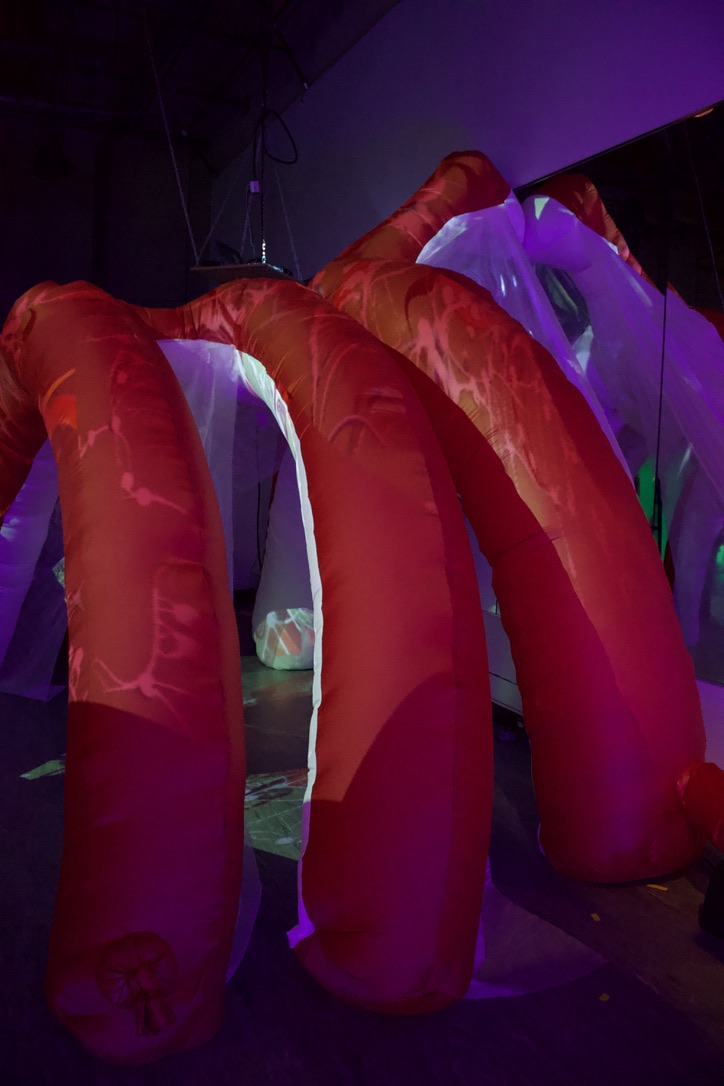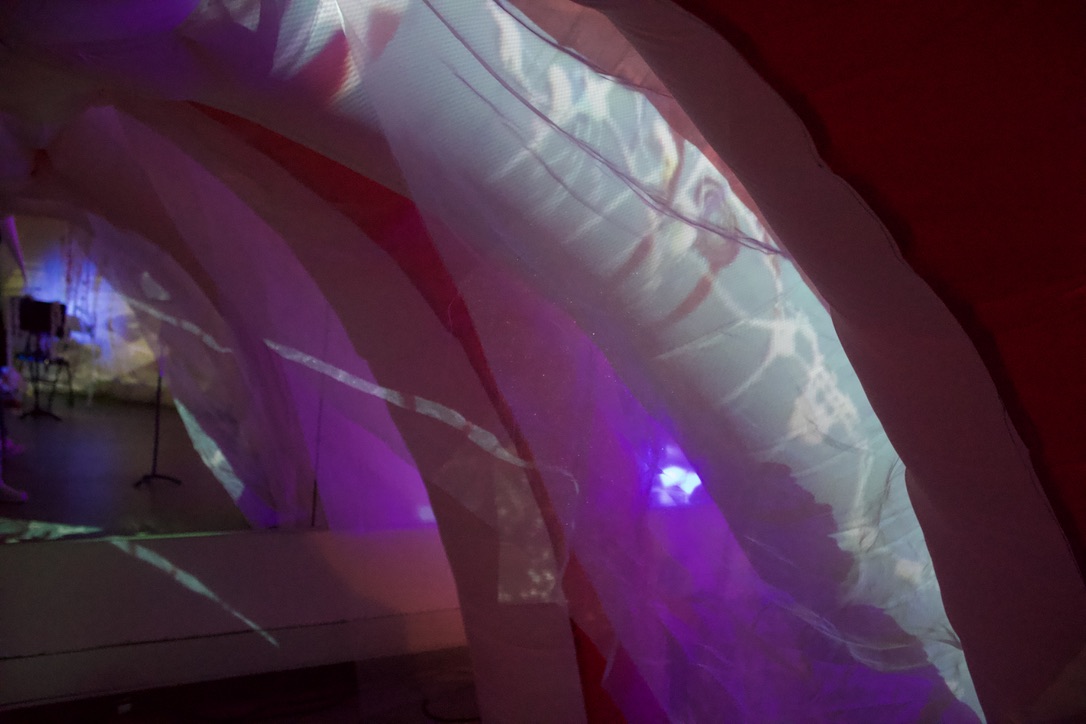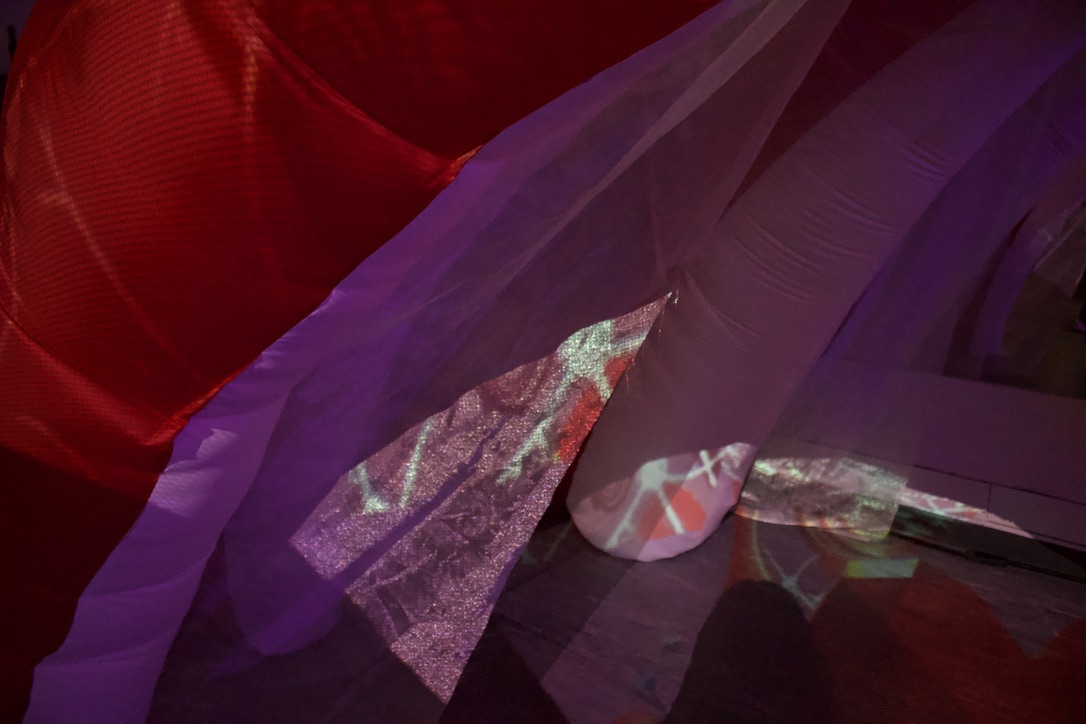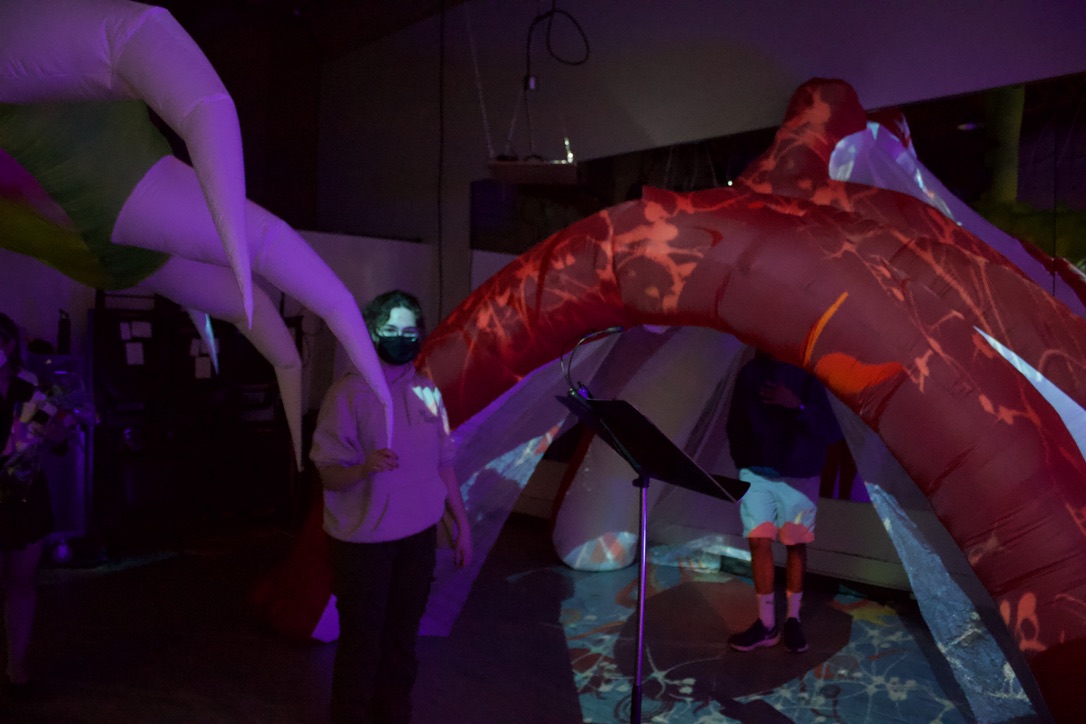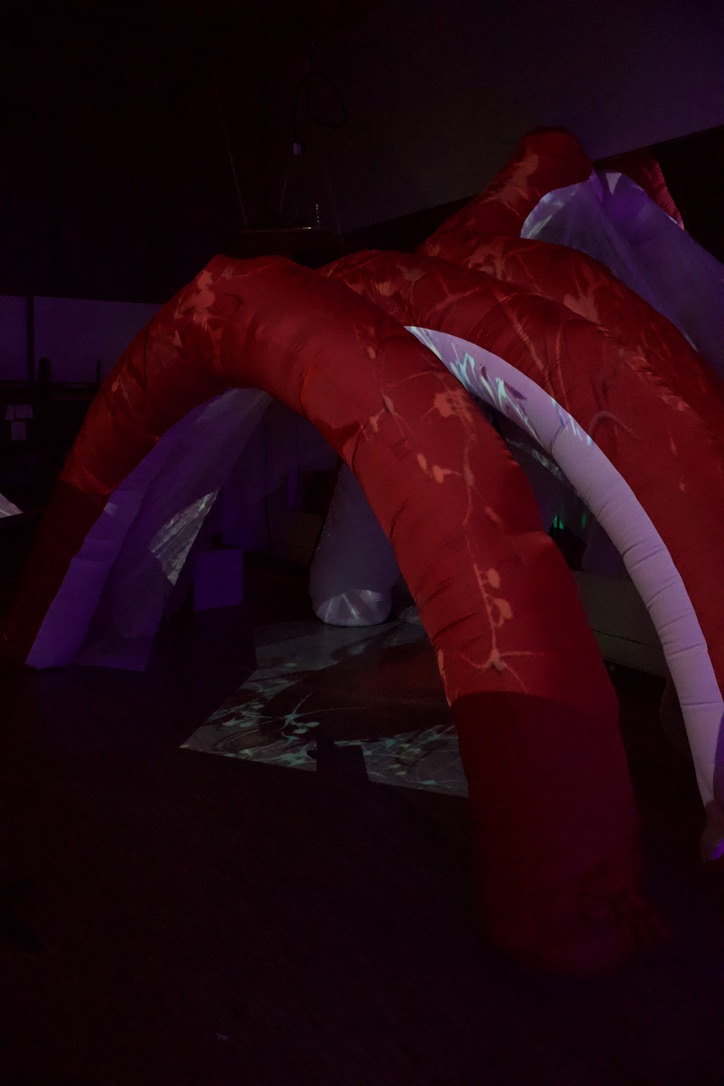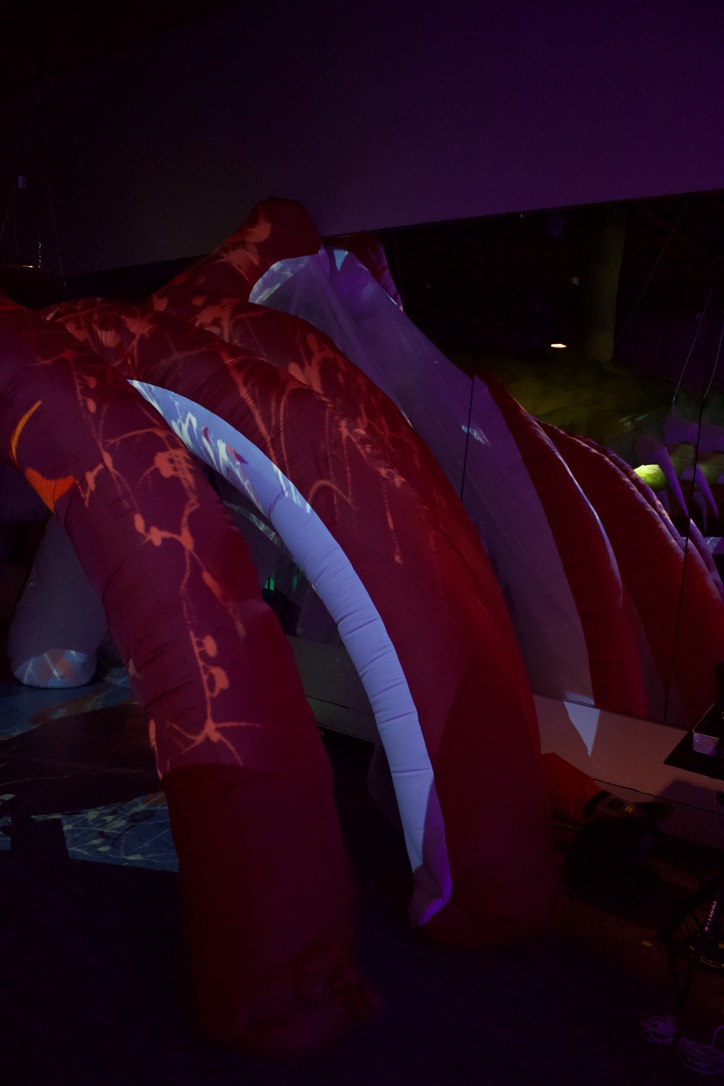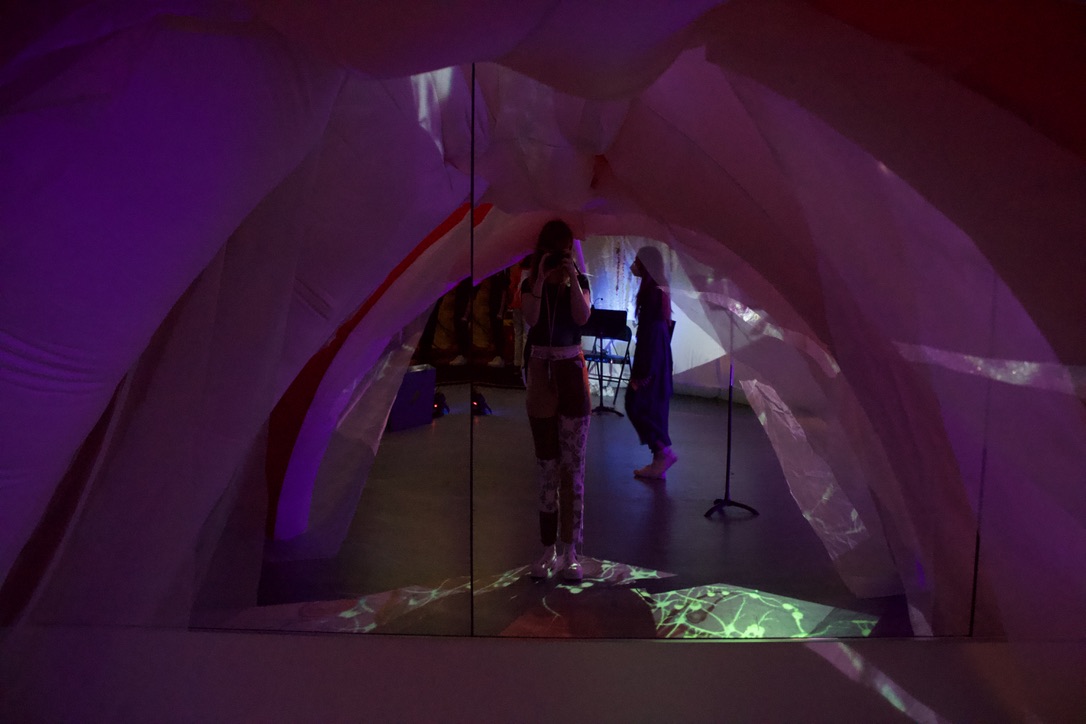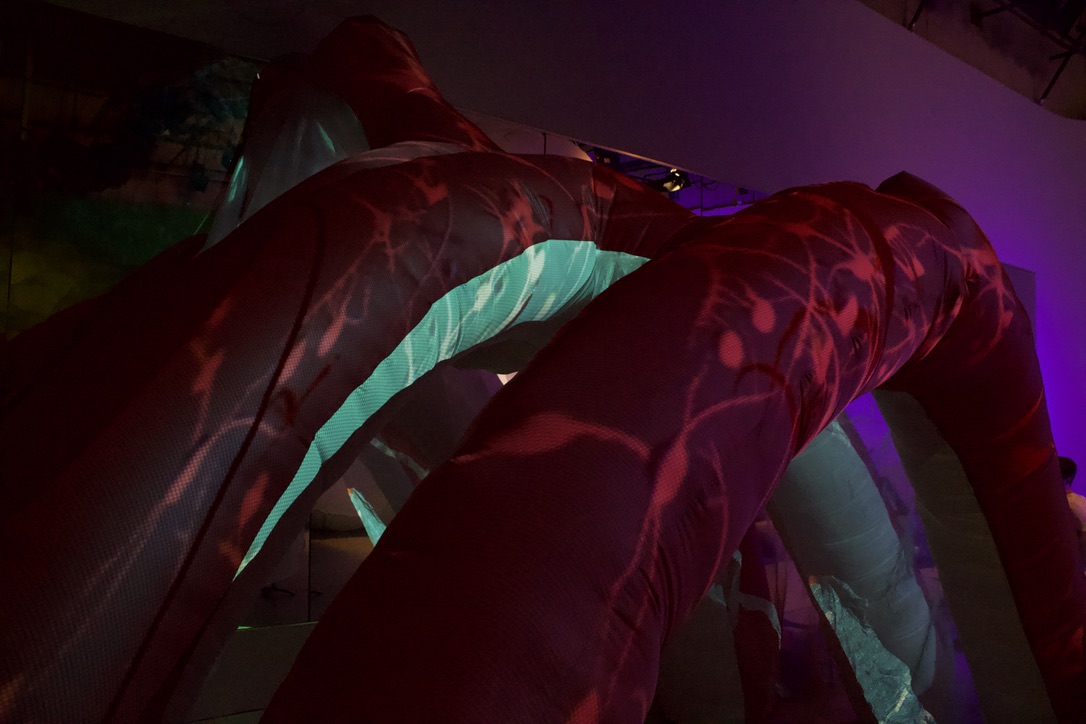Group
- How did you generate the idea and starting point for the project?
I think our idea started with hallucinations. When at WQED I had told Jiyeon and Asad that I thought it would be cool if we did something around that idea. I think once getting into the space, Jiyeon thought of having a dome or some sort of space to walk into, and we all enjoyed the idea of it. With hallucinations still in mind, the mirror really struck us as a prop that we could use to further that idea of a weird space, and along the way of drawing I kind of ended up turning it into anatomy, and a place that would just be super weird.
- What was the path that you took from beginning to end to accomplish the project? Please upload 5-10 photos to illustrate your story.
I mean first, we started with Rhino, which took us a while. Once we had most of the pieces squished we were able to start cutting pieces. We started to cut pieces using the projector and cut and sew pretty much until we finished.
- What were the challenges you encountered and how do your team overcome them?
There were a couple of challenges we encountered along the way. There were issues with projectors – we first struggled with getting comfortable with the setup so that we could trace all of our pieces. There were also issues with lending as there were multiple times where we weren’t able to get access to the resources we needed. We overcame this by regularly communicating with Olivia to make sure we did have access to lending resources.
We also struggled with fabric availability. There wasn’t enough white ripstop for our project so we had to resort to using red on the outside of the ribcage and white on the inside so that we were still able to create that experience on the inside that we intended.
We had some issues with availability – we were constantly asking ourselves who was free all the time. We found that using a google sheet to write down our availability was super helpful in knowing when our schedules overlapped.
- What were the “happy accidents” that you encountered along the way?
I think we had a few things work out. In one case I had accidentally had Asad sew some pieces the wrong way, but because of how our rhino file was made, we were able to use them for another part of the arch, which was awesome cause we did not have to seam rip. We also were unable to have our skrim be on both sides sewn in, it was just too hard to think through and be able to turn things inside out. I think this worked out because it added a breathing element to our piece, and when the show was packed it allowed for people to travel in around the pieces and not just from the arch whi9ch was cool. I think another happy accident was the animation team. I am not in love with the animation(@ georgia), but I think it being the heart instead of something hallucinogenic allowed people coming in to better read our piece as a ribcage, because their was a heart in it.
- Final Project: please upload 5-10 photos of your final project and 3 sentences that describe what your final project is (not what you intended, but what it is now that it is finished).
Our final project is about entering a space both outside and inside your body and anatomical structure and finding out what lies there. Our reflections elongate the journey through the ribs and allow you to pass through and see yourself… inside yourself. It is both an adventure of a few steps, but potentially a space to relax in your body and be either comforted or relaxed by feeling that you are in a ribcage.
ASAD:
- What aspects of your project or process were most successful?
- Being so meticulous about our planning in Rhino really helped us stay organized and assemble the arches smoothly. Getting help from Sean was also super crucial in making sure we squished the design in the best way possible so that we had to cut as few pieces as possible.
- What were a few of the challenges you encountered and how did you overcome them?
- One challenge we had was after we had sewn the first arch and were ready to attach the second one, we couldn’t figure out how to attach the scrim from the first arch to the second arch. We decided instead to then let the scrim stay open and create a sort of gill-like effect with the ribcage. We also had to deal with running out of white fabric, so we instead switched to red for the top of the ribcage and kept the white on the inside.
- What are the three top things you learned from this experience that you will take with you into future project experiences?
- 3-dimensional thinking: understanding how to model in 3D and think about assembling a 3D shape from 2D pieces
- Organization of a large scale project: Making sure we keep pieces organized, how do we communicate what progress we made if we were not working synchronously, version control of rhino files
- Confidence in creativity: Being able to stick up for your creative vision and making sure that you aren’t compromising to the point where you are losing the intention of your creation.
- What have you observed in yourself regarding your collaboration with teammates who bring different skills and experiences to the creative process?
- We did a really good job of delegating specific tasks between team members based on their strengths. I did a lot of the actual sewing work, while Georgia helped organize and pin pieces together, and Jiyeon did a lot of the preliminary work in Rhino.
- What is your number one piece of advice you would give to future students in this course?
- Don’t think too practically – it’s ok if you have no clue how your archway will stand up or how you will even assemble pieces to make something. Make something you are excited about and the rest will all fall into place.
GEORGIA:
- What aspects of your project or process were most successful?
I think our rhino file was really helpful in the end to cut pieces with the projector. We had some material issues however with running out of white ripstock and red which also ended up being why our arch ended up being 3 instead of 5. I think for the work flow what was really successful was being able to work with Asad to sew everything. I kind of ended up being the master of putting the thing to gether based on the rhino file, I was kindof the only one who knew how all the pieces fit together. So it worked really well when I met up with asad and I ended up pinning everything and feeding it to him on the sewing machine. We were able to work with a good rhythm this way.
- What were a few of the challenges you encountered and how did you overcome them?
We had quite a few challenges. I think what ended up being the worst was our problems with lending projectors and running out of fabric to use. I could list out an entire list of things that went wrong, it was a lot. We were able to work through them by compromising and making schedules so two people could always work together because working on this individually proved to be challenging. I think from the start we were a little behind because of mine and Asad’s involvement in the carnival. I think once we got the rhino file done we were excited to get started. We had some roadblocks on our first time tracing because the projector was too close to the wall, but we were able to fix that quickly and back up the projector. To finish the last arch we also had to sew together scrap pieces that Jiyeon found to be able to complete our long arch shapes, I think when doing this is when we realized doing the other arch was perhaps too much.
- What are the three top things you learned from this experience that you will take with you into future project experiences?
I think what helped us was being able to work well in rhythm and having people have certain roles in the project. It made it so everyone knew what they were getting into when we were working. I think one thing I would change about how we worked together was time. I get really antsy and take deadlines really seriously, I got a bit mad when I was free to work, but I couldn’t because my partners were busy. I think although we had good rhythm when working together, I would have appreciated if everyone knew how to put the pieces together, so that I did not need to be there every time a person wanted to sew, or so if I had free time I could go in myself and vis versa, and get stuff done. I think another thing I learned in conjunction with this, is that I can really push people a lot with projects, but sometimes it’s not necessary if, in the end, we get it done. I think that’s something I can work on as a peer, to be more understanding of other people’s limitations, because they are not the same as mine.
- What have you observed in yourself regarding your collaboration with teammates who bring different skills and experiences to the creative process?
I think it was really cool to work with different people, both for the Jellyfish and the Ribcage. I think in both scenarios we figured out how to collaborate with each other in different ways. I think when working with Heeyun I really liked to way we worked together, where we made the idea together, separated for a little bit, and got to work together in the end and go full circle. I think this worked really well for both of us because our free time at the start of the project did not match, but because of the extension, we were able to really work together and surprise each other. I think the fact that I knew both my partners out of class changed things for the last project, I knew their skill sets more and was able to see what area we all would be working in. It was different working on this project because for cutting and sewing we either needed two people or it was helpful to have someone else to work with, I think this was new for me, where I usually work separately and then collaborate in the end.
- What is your number one piece of advice you would give to future students in this course?
When people ask me about this course I always like to tell them that it is really fun, and you get to make a lot of amazing things, but you do have to be aware that the class is a bit of a time commitment. Especially because A lot of my friends are people who always do studio courses, to us this is like another studio, and You have to be willing to put in that amount of time while doing other crafting projects.

